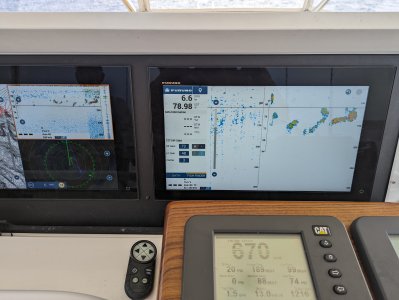B275LHW in fairing block with TZT19F sounder. Also have a 165T-50–200 on the DFF3D connected to my other TZT19F. Tuna fishing in waters from 300' to 3000' in the mid-Atlantic canyons and trying to figure out how to best optimize sonar settings, tried some tips yesterday from either this site or another, can't recall. Here's what I did using the B275LHW:
I now realize I probably should have been setting range for ~200'
Am I missing any steps or does anything above incorrect/incomplete?
Step #5, "seeing clutter" is a subjective, is it the first sign of anything on the display or is it meaningful returns?
Step #6, "clean up the screen" is also subjective - is it remove everything?
I tried various combos of the above but always felt that when I dialed clutter up it was removing any possibility for a return. When I had returns, It was generally in the top of the water column on the 200 side but it was more constant leading me to believe it was tuning error.
I don't really expect to see Tuna on the display, but would like to know more confidently where the bait is.
If you're reading between the lines, yes we got skunked on the trip but that's on the angler/boat/spread, not the sonar.
Really impressed with the equipment, I had bottom at over 1700'.
- Set screen advance for 4/1 (trolling 6-7kts)
- Set to Dual Frequency @ 53 / 170 (preset)
- Set Clutter and manual gain on both freq to 0
- Turned Auto Range off and adjusted range for depth (generally ~1k')
- Dialed gain up until I began to see clutter, then added a little more gain on each freq
- Dialed clutter up to clean up the screen
- All other settings were either default or auto
I now realize I probably should have been setting range for ~200'
Am I missing any steps or does anything above incorrect/incomplete?
Step #5, "seeing clutter" is a subjective, is it the first sign of anything on the display or is it meaningful returns?
Step #6, "clean up the screen" is also subjective - is it remove everything?
I tried various combos of the above but always felt that when I dialed clutter up it was removing any possibility for a return. When I had returns, It was generally in the top of the water column on the 200 side but it was more constant leading me to believe it was tuning error.
I don't really expect to see Tuna on the display, but would like to know more confidently where the bait is.
If you're reading between the lines, yes we got skunked on the trip but that's on the angler/boat/spread, not the sonar.
Really impressed with the equipment, I had bottom at over 1700'.
Last edited:



